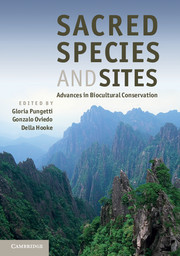Book contents
- Frontmatter
- Contents
- List of Contributors
- Foreword
- Preface
- Acknowledgements
- Introduction
- Part I Concepts and Knowledge
- Part II Sacred Landscapes
- Part III Sacred Sites and People
- Part IV Sacred Species
- 13 The conservation status of sacred species: a preliminary study
- 14 The role of taboos and traditional beliefs in aquatic conservation in Madagascar
- 15 Sacred species of national marine sanctuaries of the United States’ West Coast
- 16 Integrating biocultural values in nature conservation: perceptions of culturally significant sites and species in adaptive management
- Part V Sacred Animals
- Part VI Sacred Groves and Plants
- Part VII Implementation and Conclusions
- Index
- Plate Section
- References
14 - The role of taboos and traditional beliefs in aquatic conservation in Madagascar
from Part IV - Sacred Species
Published online by Cambridge University Press: 05 August 2012
- Frontmatter
- Contents
- List of Contributors
- Foreword
- Preface
- Acknowledgements
- Introduction
- Part I Concepts and Knowledge
- Part II Sacred Landscapes
- Part III Sacred Sites and People
- Part IV Sacred Species
- 13 The conservation status of sacred species: a preliminary study
- 14 The role of taboos and traditional beliefs in aquatic conservation in Madagascar
- 15 Sacred species of national marine sanctuaries of the United States’ West Coast
- 16 Integrating biocultural values in nature conservation: perceptions of culturally significant sites and species in adaptive management
- Part V Sacred Animals
- Part VI Sacred Groves and Plants
- Part VII Implementation and Conclusions
- Index
- Plate Section
- References
Summary
Moa raha fantatra va zalahy tsiaña fa dia fomban-drazana ka dia arahina
These are the ancestors' customs and so we follow them
(traditional saying quoted in Rahatoka, 1984)Tsy dinin-draha ny ela
Nothing is immune to change over time
(elder from Ambalavero, Commune Tolongoina)Introduction
Traditional Malagasy culture and religion are focused around respect and reverence for the ancestors (Sharp, 1994; Lambek, 2002). Objects or places strongly associated with the ancestors may be viewed as sacred (masina) and a complex system of prohibitions known as fady influences people’s day-to-day behaviour. Although the word fady may be used to describe acts which are simply breaches of good manners (Lambek, 1992; Jones et al., 2008), many fady are strict taboos which would offend the ancestors and bring supernatural punishment if broken (Ruud, 1960; Profita, 1967).
In many traditional societies, taboos have an important influence on the use of natural resources, providing protection to species or sites (McDonald, 1977; Ross, 1978; Anoliefo et al., 2003; McIvor and Pungetti, Chapter 13). Colding and Folke (2001) suggest that resource and habitat taboos in many cultures play a similar role to formal institutions for conservation in contemporary society, but that the importance of this role has not been suitably recognised. In the past there has been debate between those who consider that many taboos have developed with the purpose of conserving important natural resources (McDonald, 1977; Ross, 1978) and those who consider this attitude as a return to the much-discredited ‘noble savage’ paradigm (Buege, 1996). It is now generally recognised that people from all societies respond similarly to incentives (Winterhalder and Smith, 2000). However, taboos and other informal institutions can play an important role in natural resource management, regardless of their origin (Colding and Folke, 2001).
- Type
- Chapter
- Information
- Sacred Species and SitesAdvances in Biocultural Conservation, pp. 207 - 218Publisher: Cambridge University PressPrint publication year: 2012
References
- 1
- Cited by



